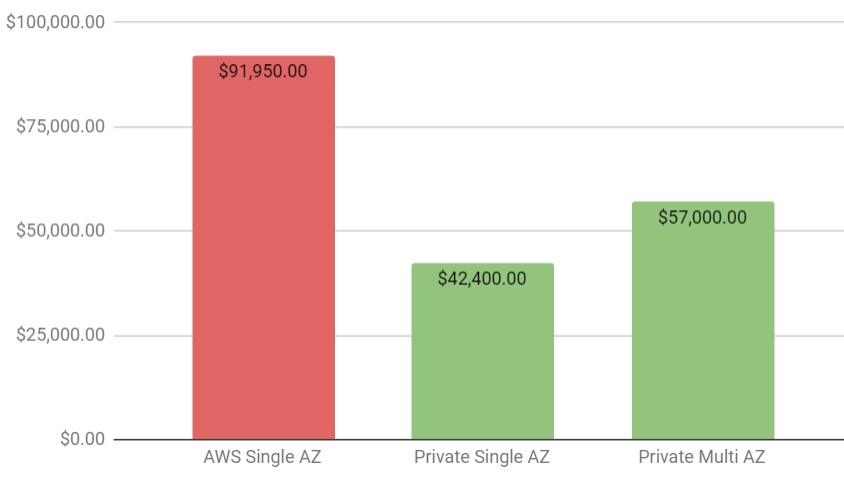Private Cloud Cost Savings
Example Scenario comparing heavily discounted and fully optimized AWS with Private Cloud Pricing

Public cloud computing is often thought to be less expensive and more flexible than private cloud or alternative on-prem solutions. The cost of private or public highly depends on each specific use case. While for smaller workloads and certain services public cloud is a perfect fit value/price-wise, it starts to differ as soon as you run large and especially bandwidth-heavy architectures.
Let us take a look at the numbers and assume some heavily discounted and optimized AWS compute set up with an alternative in your private cloud entirely managed 24/7 by us.
Scenario
A customer operates a service with an average of 160 (more or less) CPU intense instances, each with 16 cores and 64GB memory with an average outbound throughput of 5GB/s to public networks outside Amazon in a single US-EAST az (~1.6PB/month).
To optimize costs, all instances are reserved for 3 years (not upfront), and the customer has a special bandwidth discount with AWS of 40% for outbound traffic per GB. In the price comparison, we only take compute, storage, network, and support into account and no additional services such as Loadbalancers, DNS, S3, etc.
Public Cloud Resources
The customer uses the following public cloud resources to support this specific workload:
- 160x m6g.4xlarge (16vCPU, 64GB Memory)
- 12 TB EBS SSD gpurpose Storage
- 1600 TB Outbound Traffic
AWS Pricing
| Instance Cost per month* | $31,750.00 |
| Traffic Cost per month** | $52,000.00 |
| 12 TB EBS SSD gpurpose | $1,200.00 |
| Business Support | $7,000.00 |
* 3 year Reserved Instances – Not Upfront
** Including 40% Bandwidth Discount from special discount agreement
Total: $91.950
Private Cloud Resources
For an equal workload distribution, the following resources are used in the private cloud setup:
- 10x HPE DL385 Gen10, 2x AMD EPYC 7702 64-Core Processor, 1 TB DDR4
- Memory, 3.8TB NVME, 2x 10Gbit
- 3x HPE DL325, Supporting Controller Nodes
- 2x Arista 7050TX 10G Switches
- 1x Rack + PDU + Management Switch
- 1x 2x 10Gbit/s Uplink ~ 5 Gbit/s 95% included, multiple Tier 1 Uplinks, DDoS Protection
Located in a Top Tier Facility within a maximum of 5ms connectivity to all Amazon US-EAST AZ’s
Private Cloud Pricing
| Hypervisor Cost per month | $19,500.00 |
| Traffic Cost per month | $10,000.00 |
| Overhead (Rack, Switches, PDUs) | $5,400.00 |
| Fully Managed, 24×7 Support | $7,500.00 |
Includes all colocation costs, 3-year contract.
Total Single-AZ: $42.400
For high availability, the systems can be split between 2 Data Centers for 14.600 $:
| 2nd DC/RACK etc. | $5,400.00 |
| Redundant Interconnect (2x 10G), private fiber link between both DCs | $7,200.00 |
| Fully Managed, secondary DC Infrastructure | $2,000.00 |
High Availability (2 AZ) Total: $57.000
Price Comparison
Compared to the public cloud, the customer can save 54% on a Single-AZ and 38% on a Multi-AZ solution if the workload is run in a private cloud environment instead.

AWS Multi-AZ is not reflected, but running multiple AZs in AWS results in higher costs for Inter-AZ traffic which the customer also needs to pay. In comparison to the private cloud Multi-AZ solution, the customer receives a redundant 20Gbit/s interconnect link which can be used to its full extent of 20Gbit/s without additional charges, than the fiber links itself.
This cost-savings are only a plain 1:1 comparison in which we are not taking into account how this suggested setup can save the customer even more money; this only replicates the existing AWS workload to private. In the end, there are more savings and bonus included when running private infrastructures.
Private Cloud Bonuses
Private Cloud comes with some excellent features out of the box such as a 3-times replica NVME only S3 compatible object and block storage providing 12 TB of net storage capacity. In addition, you can deploy software load balancers and other appliances on the utility nodes without any additional charge.
You can run as many instances on your hypervisors as you feel comfortable with inside the resource limits. If your resource usage isn’t optimal or has free capacities in AWS, you need to change the instance types or add more instances which you need to pay. In your private Cloud, you can also overbook your resources to some extent without additional costs.
As an example, if 160 instances use only half of the capacity most of the time and only have full utilization in peak times, you can add more instances without additional costs or deploy instances for staging/test use without any issues.
You have a full overview of your resources and network usage and do not share your systems with other customers. We provide metrics and full usage monitoring for your private Cloud.
The downside of your private Cloud is, of course, that you cannot easily scale-up in a few minutes. You need to add more Hypervisors first which binds you to delivery and install times. This can partially be solved by renting on-demand hypervisors which only get paid on usage, HPE offers contracts for on-demand hypervisors or hypervisors in other specifications from the Data Center provider pool which can be used with extremely short setup times of less than one hour.
Private Cloud Ecosystem
Our Openstack Clouds are delivered as Turnkey Solution tailored to your requirements including services which you can use out of the box without additional costs such as:
- LBaaS similar to AWS ELBs for Loadbalancing
- VPNaaS for IPSec Connectivity to public and private clouds
- S3 compatible object storage and network based block storage
- Orchestration Framework (similar to cloudformation and with limited cloudformation compatibility)
- ceilometer for billing and telemetry data
- Hadoop & BigData Orchestration Support
- DNS Service
- Key Management Service for Certificate Management
- Magnum for Container management
- and much more!
Support Comparison
AWS Business Support provides the customer with <1 hour response/solution time on production impact and <4 hours on smaller production issues.
For this, you need to contact Amazon yourself on issues with your infrastructure proactively.
With our Private Cloud Setups, we monitor and maintain your Infrastructure 24/7 with a maximum response time of 30 minutes, taking direct actions on issues which come up. In addition, we can also operate on-request your deployed services and do 24/7 on-call handling your services.
Managed Ops for all Cloud relevant services (Hypervisors, Hardware Failures, Network, Storage, etc.) incidents and changes on your request are handled without any additional costs.
Conclusion
Operating your own Private Cloud can save you much money and lower your TCO depending on your usage. Moreover, you can perfectly mix it with your current public Cloud usage. You can connect your private Cloud networks with your Amazon VPC’s and use AWS to scale up and down for additional load or issues.
Most of our customers use a lot of AWS services to combine private Cloud usage such as Route53 DNS for Loadbalancing and Service Healthchecks and routing decisions. Amazon RDS for databases or even replicate their private Cloud s3 buckets to AWS for additional redundancy.
Using private or public highly depends on the workload, both have advantages and disadvantages. The trend shows a clear path for more hybrid architectures in the future, combining the advantages of both.
Get in Touch
Contact Us for more details on cost-savings with public and/or private Cloud services or if you need any help with your current Cloud infrastructure.
Pricing Information
Please note that the pricing information on this page may not be 100% accurate. The calculation was performed in early 2021 based on the experience with our customers and their different projects. On top of that, public exposed AWS pricing information is subject to change.
If you are interested in our pricing, please get in touch with us: our pricing depends a lot on chosen hardware and specs*.
*As an example, 100G networking is more expensive then 10G based networking, AMD CPUs are cheaper than Intel CPUs and so on.
